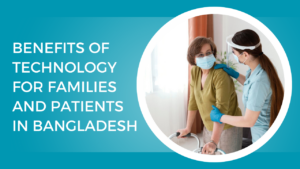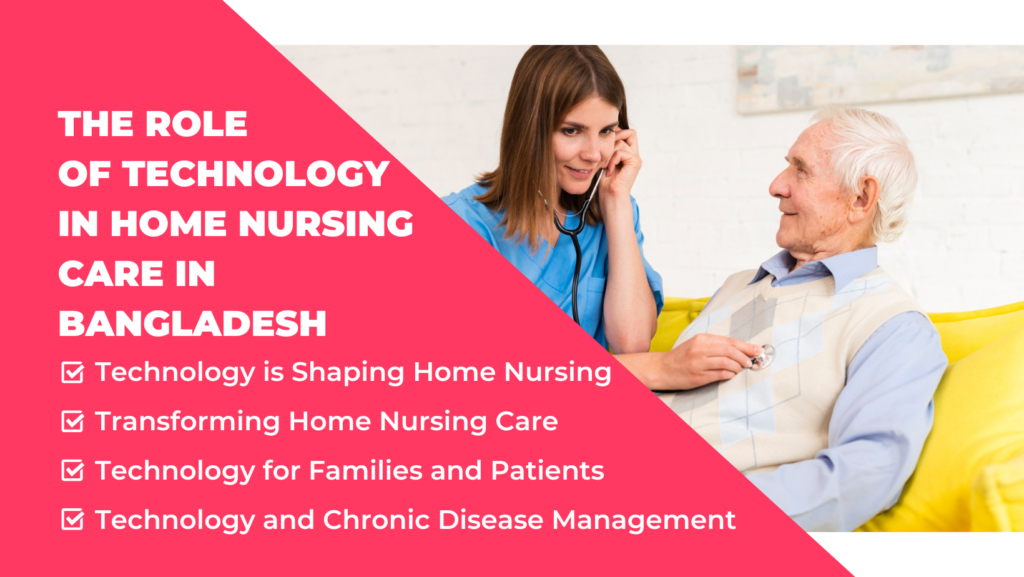The Role of Technology in Home Nursing Care in Bangladesh
How to Choose a Reliable Home Nursing Care Provider in Dhaka, Bangladesh
The technology behind home nursing care enhances the capability of caregivers to monitor patients’ health remotely through improved communication, hence making it easier for them to be looked after smoothly. Home-based nursing care in Bangladesh is more personalized and often much more efficient, especially in highly densely populated urban centers like Dhaka, where there is usually much congestion within hospitals. In this aspect, the integration of technology would translate to the fact that patients receive medical support in real time, with caregivers monitoring health metrics with much supervision, thus not necessarily requiring them to make frequent hops to the hospitals.
বাসায় বসে মেডিকেল সার্ভিস পেতে এখানে ক্লিক করুন: Click
ঘরে বসে নার্সিং সার্ভিস পেতে এখানে ক্লিক করুন: Nursing Agency
বাসায় বসে কেয়ারগিভার সার্ভিস পেতে এখানে ক্লিক করুন: Caregiver Agency
02. Key Technologies Reshaping Home Nursing Care in Bangladesh
Below are some of the technologies that have been at the frontline in changing home nursing care:
A. Remote Monitoring Tools
It enables health professionals to know the patients’ conditions concerning their vital signs and health status without them having to leave their homes for it. Such devices as monitors of blood pressure, pulse oximeters, and glucose monitors may serve to send real-time data to health providers, enabling timely interventions where necessary. This technology is very applicable in the managing of chronic conditions such as diabetes and hypertension, so common in Bangladesh.
Benefits of Remote Monitoring Tools:
- Real-time Health Data: It will highlight the right insights into the patient’s health and allow for immediate responses in case of an emergency.
- Less Hospitalization: The periodic visits to the hospital by chronic patients can be avoided.
- Improved Patient Comfort: Care is provided in the familiar environment of a patient’s home, thereby improving comfort and mental well-being.
B. Telemedicine and Virtual Consultations
Telemedicine platforms facilitate a doctor or specialist consultation from the comfort of one’s home. It is very helpful for those patients living in rural Bangladesh, where access to health facilities is very poor. The ability of home nurses to consult doctors over video calls, advice in real time, and modify care as needed;.
Benefits of Telemedicine in Home Nursing Care:
- Reaching out to Specialists: Home nurses can reach out to doctors or specialists for advice on an urgent basis.
- Convenience: This reduces the need to travel for a patient, which is very helpful in cases where the patient has some kind of mobility problem.
- Economical: Saves money spent on traveling and other expenses linked to hospital admission.
C. Health Tracking Apps and Wearable Devices
It was never difficult for either a patient or an attendant to track health due to smartwatches and fitness trackers that record heart rate, sleep quality, and physical activity, among other things. Equally, in Bangladesh, the gadgets could be used by the caregivers to the patients to ensure daily routines in diet and exercise schedules, monitor their conditions of health, which will provide appropriate information to help individualized care plans.
Key Benefits of Health Monitoring Applications and Wearables:
- Always On: Keep tab of your health metrics throughout the day.
- Empowerment of Patients: More involvement on the patient’s part in taking care of their health.
- Data Collection: It enables the physician to retain information and study it later to understand the pattern and trend in the health status of patients.

3. Benefits of Technology for Families and Patients in Bangladesh
The implementation of technology in home nursing care has particular advantages to the patients and families in Bangladesh, where the health resources can be stretched in the urban areas and negligible in the rural ones. Some of the important benefits are as follows:
A. Improvement of Patient Safety and Quality of Care
With technology, there is less room for human error in care delivery. Automated reminders on medication, digital records, and real-time monitoring of data enhance better safety and precision in the administration of care.
B. Improved Accessibility for Rural and Urban Patients
This helps in telemedicine and home monitoring to avail quality care for the rural patients without making them travel very far. Technology provides an easier way for regular checkups and care in the cities of Dhaka and other cities.
C. Reduced Burden of Family Care
It will also allow families to be active participants in a patient’s life without actually being there. For example, the patient’s caretaker can check health metrics at his or her convenience by using apps or talk to caregivers remotely through the web. This is easier to do in combination with other daily activities.
4. Technology for Chronic Disease Management
Diabetes, heart disease, and several respiratory ailments are part of the diverse groups of chronic diseases. Speaking about the long-term chronic conditions, technology-supported home nursing care is pretty feasible to conduct. The care for chronic patients may be supported with a hub for remote monitoring, regular check-ups with telehealth, and medication management applications.
Example: Technology in Diabetes Management
This would be possible through the use of technology in diabetic patients through continuous glucose monitoring, timely administering of insulin, and monitoring of their diet. These activities would hence be coordinated through apps and wearables to ensure stable health status that reduces risks associated with complications.
5. Technological Implementations in Home Nursing Care-Challenges to Be Considered
Although technology has enormous potentials, in Bangladesh, its practical application within home nursing care has not been devoid of problems.
A. Cost of Devices and Accessibility
The gadgets and machines involved in high technology are very expensive. As much as these improve the level of care, most families cannot afford them. Government subsidies, sharing, and affordable device alternatives may convince people to avail themselves of this service.
B. Training and Education for Caregivers
Caregivers, in particular, need training in how to capitalize on such technologies. Training regarding devices and data interpretation should be provided by nursing agencies in Bangladesh as a matter of course to enhance their effectiveness in caregiving.
C. Data Privacy and Security
Where there are digital tools, there also come responsibilities in the form of data privacy. It is very important that health care providers maintain strict standards for personal health information privacy.
6. Future of Technology in Home Nursing Care in Bangladesh
New tools can be adopted in home nursing care with the advent of technology. Some of the future trends which can show promise in this sector in Bangladesh are hereby discussed.
A. Artificial Intelligence for Predictive Analytics
AI will analyze data from patients to predict health events, such as falls or changes in vital signs, which can further improve patient safety and reduce the rate of emergencies.
B. Mobile Health Units
Given the remote monitoring tools, mobile health units can be dispatched to the rural areas so that more areas in Bangladesh can take advantage of the home nursing facilities.
C. Advanced Wearables for Total Health Monitoring
It follows that next-generation wearables will go a step further to make detailed health insights, like ECG, hydration levels, and stress indicators, meaningful insights for better patient care planning. like



